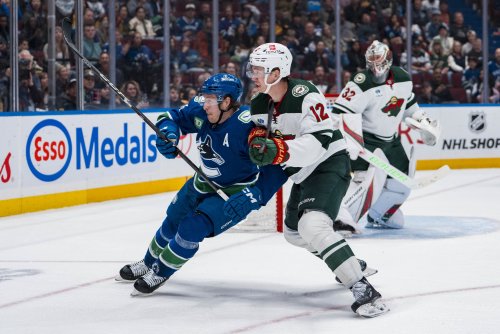
The moves made in the past two off-seasons have hampered the Minnesota Wild. The Wild have backed themselves into the proverbial corner regarding the NHL's salary cap, and it will only worsen.
We know this, Wild general manager Bill Guerin knows this, and, one would hope, head coach Dean Evason knows this.
So when those off-season moves were made — buying out what remained of the goliath contracts for Ryan Suter and Zach Parise and letting a streaky but extremely productive Kevin Fiala walk— there is no doubt in our minds that Evason was consulted on the decisions. Heading into training camp, Evason was optimistic that the Wild would be able to generate the offensive gaps from within the organization.
At the beginning of training camp, in an interview with Pioneer Press, Evason said, "you can go up and down our lineup from last season, and there are a lot of guys that maybe people didn't think would have the offensive production that they did."
The coach was correct, as the Wild benefitted greatly from career-high offensive outbursts from Ryan Hartman (34 goals and 65 points) and Marcus Foligno (23 goals and 42 points) that helped buoy the team to a top-five offense for the 2021-22 season. For Evason, he was hoping for more of the same for 2022-23. "It could be the same thing this season as far as numbers go. We're hoping that it's several people that step up for us. We want our guys to compete. There's going to be an opportunity,” he continued.
That opportunity has been there for some players, as young guns like Sam Steel and Matt Boldy are getting plenty of runway on the Wild's top lines. Those opportunities have yet to translate into replacing the offense that bled away in the offseason. Foligno and Hartman have predictably come crashing back to earth, on pace for only 16 goals and 32 assists combined this season. Those atmospheric shooting percentages of 23.5 and 14.2 percent were never going to be repeatable when for their careers, they hit the net at a rate of 13.3 percent and 10.3 percent respectively.
While Boldy has more or less been as promised — albeit a slight step back in production with an increased reliance on him — we haven't seen the immediate jump to productive and impactful NHLer that we hoped for in fellow blue-chip prospect Marco Rossi. While we can debate the merits of Rossi's demotion to the Iowa Wild farm team in the AHL, we must discuss a player who has seemingly made the jump to impactful and productive early in his career.
After all, if the Wild bled away all the offense from their forward group, nosediving from one of the league's most dynamic offenses one season to 28th in the NHL the next, where else to get that offense than from the backend?
The Curious Case of Calen Addison
Before we discuss the treatment — or mistreatment — of a defenseman as talented as the 22-year-old Calen Addison, we must understand his impact on the ice. As a Wild defenseman, Addison is on pace for the 12th-best offensive season in franchise history. On pace for four goals and 42 points, it would be the fourth-best point total we've seen from a defenseman in a Wild jersey not named Ryan Suter or Brent Burns.
As for his general ability to drive play, generate shots and overall creation of offense, the kid is a stud. According to NaturalStatTrick.com, Addison leads all blueliners in shot attempts —70(!) per every 60 minutes— and is behind only Boldy, Mats Zuccarello and our beloved Kirill Kaprizov amongst players who have played at least 100 minutes this season. All this from a rookie defenseman, one who leads all NHL rookie defenseman in points.
We do want to be honest about Addison's value impact. A player who takes these kinds of chances to produce offense is bound to take some ill-advised risks. Attempting passes that no other Wild defenseman can make sometimes means that he is making passes that no blueliner should attempt.
He gives the puck away frequently, according to NHL.com, 1.20 times for every 60 minutes he plays. He concedes around 42 shot attempts per 60 minutes played to his opponents.
These numbers play into what we see when we watch Addison play hockey.
At least, we think they do.
Addison actually gives the puck away less than most players on the Wild, at a lower rate than players like Hartman, Zuccarello, Foligno and even Kaprizov. That's on a per 60-minute scale, so it's not because he sees less ice time than them. The 42 shot attempts per 60 minutes from opponents is also third-best on the team, behind only Kaprizov and Boldy. It's easy to forget that if you have the puck and you're peppering it at the opponent's net, they don't have the opportunity to do the same to you.
There's no doubt that the risks Addison takes lead to better chances for the opposing team, but hockey games aren't won in single plays. If you can tilt the ice in your favor for more of the game than your opponent, you will win the game more often than not. That's the strength of Addison's play.
He tilts the ice in his team's favor, generating boatloads of offense from the point, adding +1% xGF above the team average, as shown in the heat map from HockeyViz.com. He isn't a net positive on defense, but he also isn't a negative as his reputation dictates. He's a boon on the powerplay.
As the principal return in the deal that shipped Jason Zucker to the Pittsburgh Penguins, the young puck-moving blueliner is exceptional.
Watch the Game, Nerd
Ahead of their 2-1 win over the Los Angeles Kings last night, the Wild decided to scratch Addison for his fourth straight game. Looking back at his scratch in the game against the Colorado Avalanche last week, Addison said "it's frustrating." His last game in the Wild lineup was a 2-1 shootout loss to the Florida Panthers. His stat line was productive with one assist and one shot, but unremarkable.
So what about his performance in this game that has led to four straight, healthy scratches for Addison? Looking back at the game, a few things stand out.
Immediately off the bench, Addison prevents an attempt at a breakout pass from the Panthers player. While he isn't active enough on his skates to completely extinguish the Panthers' breakout, he does recover and force the forward to take a bad-angle — and ultimately completely safe — shot from near the goal line. For the most part, not a great shift, but ultimately not a bad one either.
First off, some praise. Calen Addison is the powerplay cure for what ails the Minnesota Wild. He moves the puck, generates shots, and is proficient at making the breakout pass. Addison does a great job of generating speed for the attack through the neutral zone; he keeps the puck moving along the point, ultimately forcing the goaltender to change angles. At one point, he does an excellent job keeping the puck in the offensive zone. There's a reason he makes the Wild powerplay exponentially more dangerous.
Another excellent example of Addison's value on the powerplay. Again, he does a great job of keeping the puck moving along the point, something that even elite defenseman like Jared Spurgeon or Jonas Brodin have struggled with in their careers. In total, Addison had 6:52 of powerplay time in this game and an absurdly high percentage of his 14:49 of total ice time. Both management and coaching staff know his value to the powerplay and seemingly rob him of even-strength time for simple mistakes.
The first genuine mistake of the game for Addison and the Minnesota Wild. While Jon Merrill is tasked with seemingly chasing down the puck carrier, Addison patrols the front of the net.
Eventually, in a similar situation, Addison is unable —or unwilling— to close the gap on his man and allow a clean deflection off a point shot.
We don't have more clips to share because not much happened between that Panthers goal and the eventual game-winning attempt in the shootout at the end of the game.
It's hard to pinpoint exactly what would have signaled that an extended stay in the press box would benefit the young defenseman. He tallied a point, and in a 2-1 shootout win, it's hard to say that defense was a problem for the Wild that night. Perhaps the inability to clear out the front of the net was a sticking point for the coaching staff, but when paired with sluggish 31-year-old Merrill, I think it's fair to ask why it often felt like it wasn't Addison's role to put the pressure on the puck-carrier down low.
Much Ado About Nothing
The last game that Calen Addison played for the Minnesota Wild really highlights his tenure with the team. He occasionally makes frustrating mistakes, like ill-timed and ill-advised drop passes, while bringing a dimension to the offense —and even more so the powerplay— that the organization lacks and would be hard-pressed to replace.
There's a reason the Wild powerplay has seemingly done a 180-degree turn from a mediocre powerplay in 2021-22 to the eighth-best in the league this year, amongst other teams like the Colorado Avalanche and the Boston Bruins. The coaching staff clearly recognizes this, as Addison has been afforded boatloads of ice time on the man advantage. His 3:47 of powerplay time as a defenseman is over two and a half more than the next player, Jared Spurgeon, averaging 1:15 per game.
Offensive defensemen are always under greater scrutiny for their defense because of the traditional way that we view the position. Despite this, Addison is a great player, a difference maker and at such a young age on a team, absolutely frothing at the mouth for offense. He has his warts, as any player does, but his strengths plaster over many of the weaknesses that the Wild's salary-cap management and personnel decisions have created.
As a rookie with a desirable skillset for any NHL team, there should be cooperation between the team and the player to see him succeed. By scratching him for four-straight games, it's impossible to see that sort of collaboration happening.
In the future and the present, the Wild are in a bind of their own doing, and Addison is a part of the solution that would see them take advantage of the young core and young superstar they have on their roster. Addison is a restricted free agent this upcoming offseason —albeit without any arbitration rights— and his contract status will dictate how we view the young, run-and-gun defenseman's tenure with Wild.
Here's hoping that we look back on the early part of his budding career favorably.
Think you could write a story like this? Hockey Wilderness wants you to develop your voice, find an audience, and we'll pay you to do it. Just fill out this form.








Recommended Comments
There are no comments to display.
Join the conversation
You can post now and register later. If you have an account, sign in now to post with your account.
Note: Your post will require moderator approval before it will be visible.